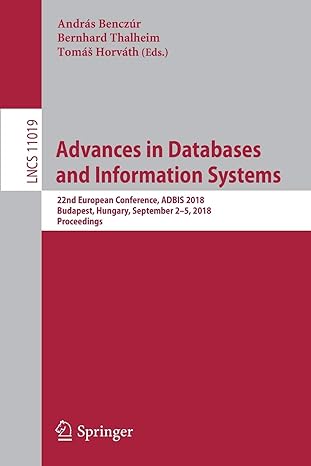Question
Help please: Create a disk scheduling simulator. Your program disksked will accept a starting track number and eight tracks to read. disksked will simulate FCFS,
Help please:
Create a disk scheduling simulator. Your program disksked will accept a starting track number and eight tracks to read. disksked will simulate FCFS, STFS, SCAN and C_SCAN and produce a report of which tracks will be read in which order and the amount of head movement for each track.
Learning Objectives
Demonstrate understanding of the four disk scheduling algorithms documented in the text.
For each scheduling algorithm, correctly output (in order) the tracks to be read, the amount of head
movement for each track read and the total head movement for all eight tracks.
Assignment
Begin by installing the tools you will need for this assignment:
mkdir -p ~/cs3100/lab6 cd ~/cs3100/lab6 The file cuke.tar file will create, when extracted, a small number of folders containing the cucumber scripts and a Makefile. You should not be required to modify the Makefile for this assignment. Create and edit disksked.c using the text editor of your choice. Here are the basic requirements for disksked.c:
Usage: ./disksked START T1 T2 T3 T4 T5 T6 T7 T8
START is the current track of the disk read-write head.
T1-T8 are tracks to be read. Your disksked must process exactly eight track values.
All track values tested for grading will be integers between 0 and 256
All track values are read by your program from the commandline as shown above.
You are to emulate the following disk scheduling algorithms with the following modifications where noted:
First Come First Served (FCFS) Tracks are processed in the order received, from the starting track to each of the 8
tracks in order on the command-line from left to right.
Shortest Seek Time First (SSTF)
Tracks are processed from the absolute value of the shortest distance from the current track, beginning with the starting
track.
If there are two tracks that are equal distance from the current track, choose the first one (the earliest one in the list) and
move there first.
SCAN
Re-order the tracks, so that from the current track, move to higher numbered tracks
first, then reverse to the lower tracks. Process all of the higher numbered tracks in ascending order, then move to the
lowest numbered track and process the lower numbered tracks in ascending order.
Do not move to track 0 or to the end of the disk during your scan. Some of you might recognize this variant of the SCAN
algorithm as the LOOK algorithm.
Circular SCAN (C-SCAN)
Re-order the tracks, so that from the current track, move to higher numbered tracks
first in ascending order (as in SCAN), but then reverse direction and process the lower
numbered tracks in descending order.
Some might recognize this variant as the C-LOOK algorithm.
Generate a report that contains four lines, in this order: FCFS, SSTF, SCAN and C_SCAN.
For each algorithm simulated, output (all on one line):
the algorithm name followed by a colon and a space
"Start:" followed by the starting track number and a space
the eight tracks in order of processing, each followed by a colon and the count
of tracks needed to move to that track, each followed by a single space
"Total:" and the number of total tracks moved during the simulation.
Sample Output
name@name-Ubuntu:~/cs3100/lab6$ ./disksked 53 98 183 37 122 14 124 65 67 FCFS: Start:53 98:45 183:85 37:146 122:85 14:108 124:110 65:59 67:2 Total:640 SSTF: Start:53 65:12 67:2 37:30 14:23 98:84 122:24 124:2 183:59 Total:236 SCAN: Start:53 65:12 67:2 98:31 122:24 124:2 183:59 14:169 37:23 Total:322 C_SCAN: Start:53 65:12 67:2 98:31 122:24 124:2 183:59 37:146 14:23 Total:299 name@name-Ubuntu:~/cs3100/lab6$
Files
Here is a list of the files created or modified in this lab:
disksked.c Please add your name, lab # (6) and class # (CS 3100) as comments at the top of disksked.c.
Additional Requirements
Please write this program as simply as possible. Do not add any prompts, output or any file I/O except as specified. It is ok for you to generate debugging information while you are testing but use an environment variable as a flag so that I don't see any extraneous output when I run your program. Ask about this if you have questions. Alternatively, simply remember to remove all instrumentation prior to turning in your assignment. Your grade will depend on your adherence to these requirements.
Upload only disksked.c to
Step by Step Solution
There are 3 Steps involved in it
Step: 1

Get Instant Access to Expert-Tailored Solutions
See step-by-step solutions with expert insights and AI powered tools for academic success
Step: 2

Step: 3

Ace Your Homework with AI
Get the answers you need in no time with our AI-driven, step-by-step assistance
Get Started


